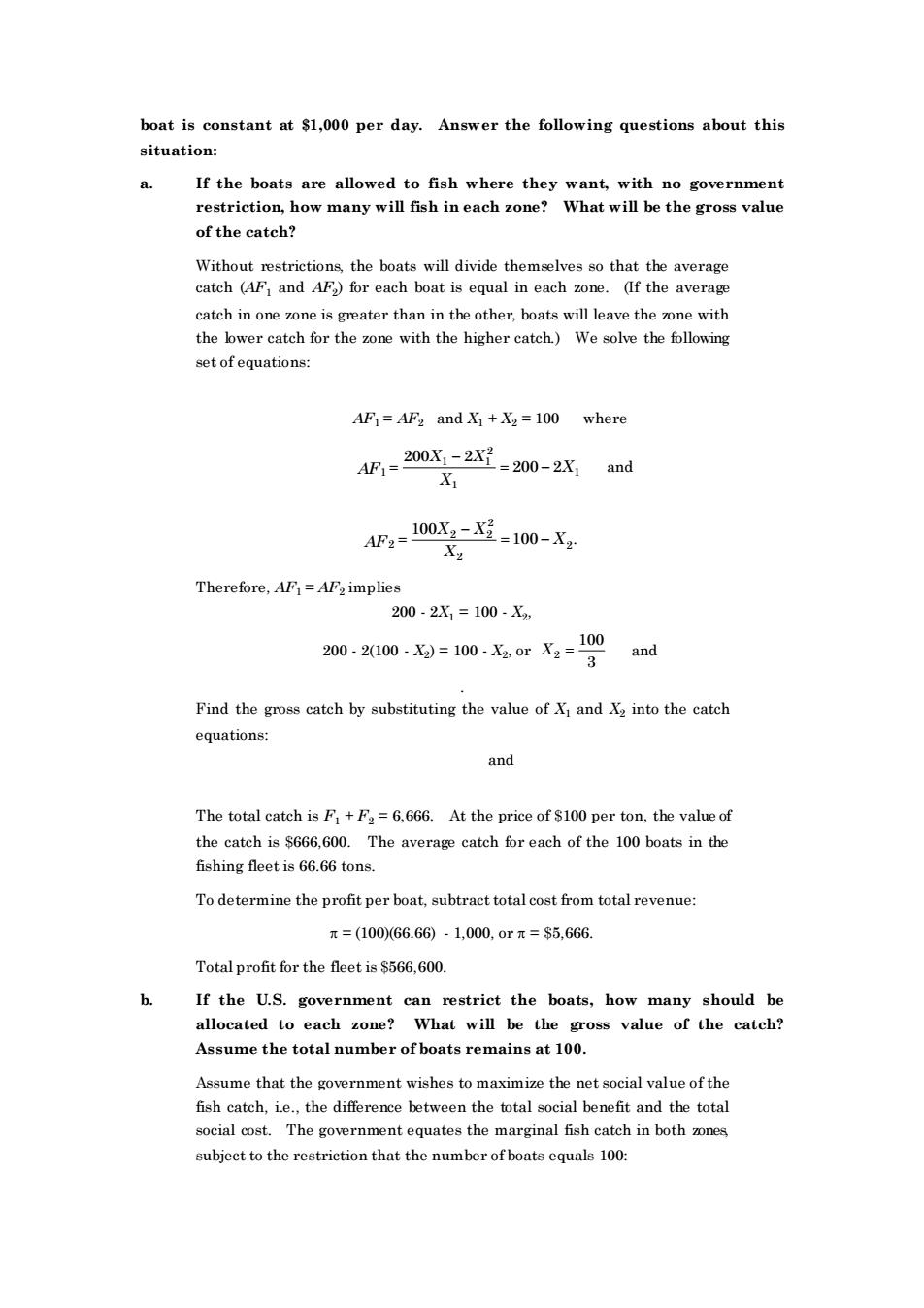正在加载图片...

boat is constant at $1,000 per day.Answer the following questions about this situation: a. If the boats are allowed to fish wher nt,with no governm aow many will fish in each zone? of the catch? Without restrictions the boats will divide themselves so that the average catch (AF,and Af)for each boat is equal in each zone.(If the average catch in one zone is greater than in the other.boats will leave the aone with the lower catch for the zone with the higher catch)We solve the following set of equations: AF:=AFz and X:+X2=100 where 4A6=200x-2 =200-2X1and A,=100-=10-X Therefore,AF1=AFzimplies 200-2X1=100.X2 2002100.x)=100.XrX2-100 and Find the gross catch by substituting the value of X and Xa into the catch equations: and The total catch isF+6666.At the price of per ton,the value of the catch is $666,600 The average catch for each of the 100 boats in the fishing fleet is 66.66 tons. To determine the profit per boat,subtract total cost from total revenue: 元=(10066.66)-1,000.orT=$5,666. Total profit for the fleet is $566.600. If the U.S.government can restrict the boats,how many should be allocated to each zone?What will be the gross value of the catch? Assume the total number of boats remains at 100. Assume that the gov rnment wishes to maximize the net social value of the fish catch,ie the differece between the total social benefit and the tota social cost.The government equates the marginal fish catch in both mones subject to the restriction that the number of boats equals 100: boat is constant at $1,000 per day. Answer the following questions about this situation: a. If the boats are allowed to fish where they want, with no government restriction, how many will fish in each zone? What will be the gross value of the catch? Without restrictions, the boats will divide themselves so that the average catch (AF1 and AF2 ) for each boat is equal in each zone. (If the average catch in one zone is greater than in the other, boats will leave the zone with the lower catch for the zone with the higher catch.) We solve the following set of equations: AF1 = AF2 and X1 + X2 = 100 where 1 1 1 2 1 1 200 2 AF 200 2 X X X = X − = − and 2 2 2 2 2 2 100 AF 100 X X X = X − = − . Therefore, AF1 = AF2 implies 200 - 2X1 = 100 - X2 , 200 - 2(100 - X2 ) = 100 - X2 , or X2 100 3 = and . Find the gross catch by substituting the value of X1 and X2 into the catch equations: and The total catch is F1 + F2 = 6,666. At the price of $100 per ton, the value of the catch is $666,600. The average catch for each of the 100 boats in the fishing fleet is 66.66 tons. To determine the profit per boat, subtract total cost from total revenue: = (100)(66.66) - 1,000, or = $5,666. Total profit for the fleet is $566,600. b. If the U.S. government can restrict the boats, how many should be allocated to each zone? What will be the gross value of the catch? Assume the total number of boats remains at 100. Assume that the government wishes to maximize the net social value of the fish catch, i.e., the difference between the total social benefit and the total social cost. The government equates the marginal fish catch in both zones, subject to the restriction that the number of boats equals 100: